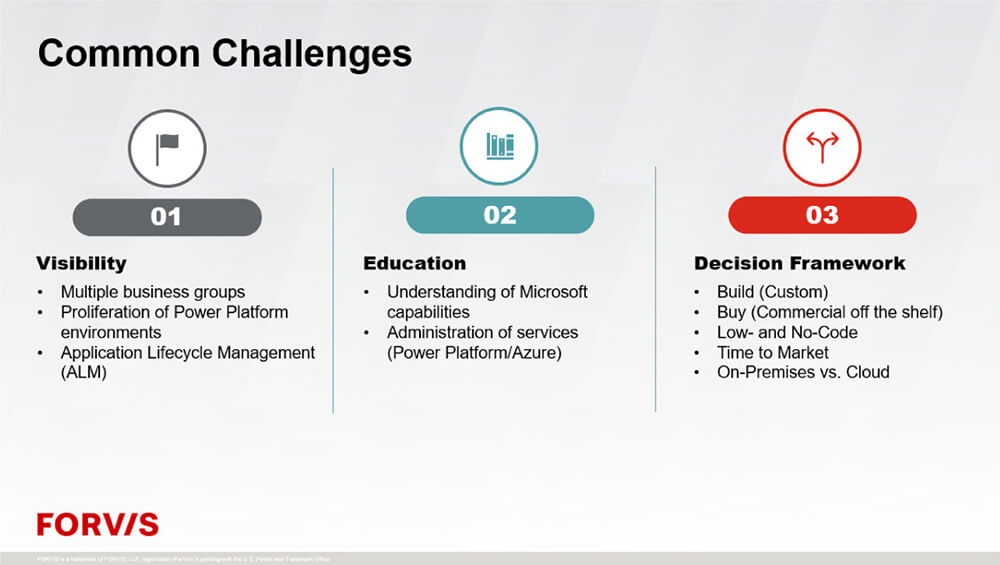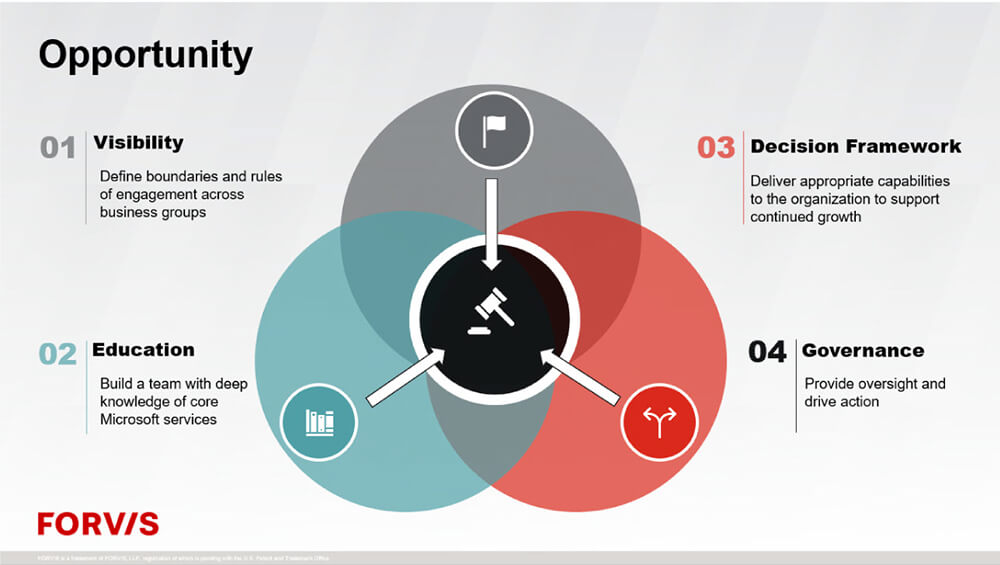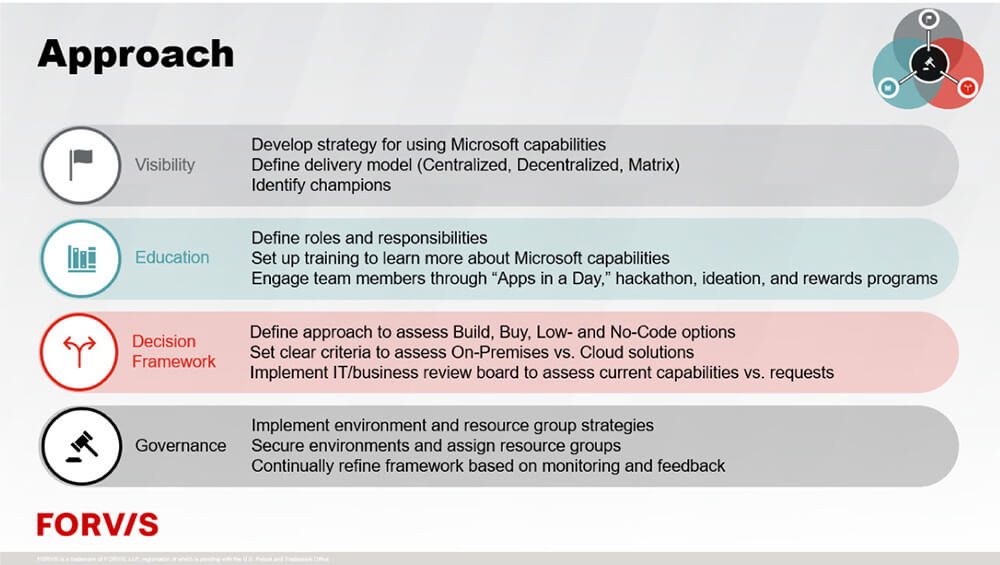The introduction of the Microsoft Power Platform and other low-code development tools is revolutionizing business process automation and application development. These tools can help software developers and everyday users create apps, flows, reports, and chatbots with ease. The introduction of low- and no-code development tools is empowering citizen development and creating opportunity.
In business, citizen development and citizen developers can be granted permission by internal IT leaders to create new applications. Broadly, a citizen developer can be defined as an inquisitive individual looking for a more efficient way to complete tasks by using technology. Citizen developers don’t need programming experience and can assist in the development of business-critical applications.
With the right governance, training, and tools in place, citizen developers can simply build their own solutions rather than waiting for IT professionals to work through their backlog. In this FORsights™ article, we’ll cover automation governance, the Microsoft Power Platform, and the opportunity citizen development can generate.
What Is Automation Governance?
Automation governance is the process of establishing a structured framework to help guide the implementation, management, and supervision of automation projects within an organization. An automation governance framework should identify roles and responsibilities, compliance requirements, controls, approved tools and systems, security standards for system access, testing and auditing procedures, and more.
Governance also means making sure business leaders are aware of all their technology options and have a methodology to assess value and risk. Assessing and managing risk is paramount to attaining the business benefits automation can provide.
Microsoft Power Platform
With low-code development tools, businesses can quickly create and deliver applications without having to rely solely on traditional programming. Low-code tools help make it easy to design and build apps, workflows, or processes with simple functionality quickly and efficiently.
The Microsoft Power Platform includes a suite of low-code development tools, including Power BI, Power Apps, Power Pages, Power Automate, and Power Virtual Agents. Each tool is natively extensible across the Microsoft Azure cloud platform and can connect to and extend the capabilities of custom or legacy systems and data collections.

Citizen Development & Adoption of the Power Platform
The Microsoft Power Platform has become increasingly popular over the last several years. With the introduction of Microsoft Copilot, a new tool powered by artificial intelligence (AI) that uses large language models (LLMs) trained with in-house data stored across Microsoft 365 services and accessed through Microsoft Graph, usage is accelerating.
As user adoption increases, many organizations face several common challenges. Converging citizen development, the Microsoft Power Platform, and automation governance should be a priority for practically every business leader right now. Organizations must address how to empower their teams while still maintaining some control over automation and low-code development tools.
Here are some common challenges that have been observed:

- Visibility
- Multiple groups within an organization are utilizing the Power Platform, but no true ownership exists.
- Governance of the Power Platform and the proliferation of Power Platform environments continue to push the bounds of available licensing.
- Proper application life cycle management (ALM) and a standard approach to the creation of these solutions aren’t addressed.
- Education
- Knowledge of the Power Platform and its capabilities is widely unknown.
- Administration of Power Platform and Azure services and environments is loosely understood.
- Decision Framework
- Organizations have not formalized when to:
- Build, i.e., custom development.
- Buy, i.e., commercial off the shelf (COTS).
- Use low- or no-code tools.
- Consider application time to market.
- Use On-Premises versus Cloud solutions.
- Organizations have not formalized when to:
Each scenario can be summarized in a quote by former Secretary of Defense Donald Rumsfeld:
There are known knowns—there are things we know we know. We also know there are known unknowns—that is to say, we know there are some things we do not know. But there are also unknown unknowns, the ones we don’t know we don't know.”1
This quote illustrates many of the challenges because business teams often don’t know about the “shadow IT” going on within various business groups, what capabilities low- and no-code tools can provide, and how application time to market can impact the organization.
The Opportunity
Organizational change and technology advancements are inevitable. How organizations handle these changes can lead to significantly different outcomes. Organizations must balance the advancements technology can provide with a disciplined governance approach so innovation and information security can grow together.

The Approach
When an organization is ready to embrace digital transformation, it’s time to create a proper governance framework. It’s important to note that it’s never too late to implement governance. In addition, governance shouldn’t be viewed as a hindrance to innovation. Instead, it can be viewed as a structured approach to advancing innovation so the organization can scale sustainably.
There are some simple steps to take to help satisfy technology demand while safeguarding the organization with proper controls. Here are recommended best practices for converging citizen development, the Microsoft Power Platform, and automation governance:

- Visibility
- Develop strategy for using Microsoft capabilities.
- Define delivery model (Centralized, Decentralized, or Matrix).
- Identify champions.
- Education
- Define roles and responsibilities.
- Set up training to learn more about Microsoft capabilities.
- Engage team members through “Apps in a Day,” hackathon, ideation, and rewards programs.
- Decision Framework
- Define approach to assess Build, Buy, Low-, and No-Code options.
- Set clear criteria to assess On-Premises versus Cloud solutions.
- Implement IT/business review board to assess current capabilities versus requests.
- Governance
- Implement environment and resource group strategies.
- Secure environments and assign resource groups.
- Continually refine framework based on monitoring and feedback.
Final Thoughts
The Insights & Automation team at FORVIS provides dedicated Microsoft Power Platform services. We can help you navigate digital transformation and manage strategic technology changes that result from large-scale organizational change. Our tailored approach to technology consulting can help you turn business challenges into opportunities. We provide:
- Advisory engagements
- Power Platform assessments
- Power Platform automations
- App-to-app integrations
- Outsourced citizen developer services
Connect with us to learn more.
Related Content
- Reasons to Consider Business Process Automation
- Copilot in Power Apps: How AI Is Transforming App Development
- Power Business Central Extension Development With Copilot
- How to Convert XML to JSON in Power Automate
- Why & How to Extract Data from PDF with Power Automate
- 1“‘Nothing Ever Ends’: Sorting Through Rumsfeld’s Knowns and Unknowns,” washingtonpost.com, July 1, 2021.

